| |||||||
| Search Forums |
| Advanced Search |
| Go to Page... |
 |
| Search this Thread |  253,130 views |
| | #1 |
| Team-BHP Support  | PICS: Apollo Tyres Chennai Factory. Detailed report on the making of a Tyre As a car enthusiast I have a keen interest in almost everything related to cars, but due to some strange fascination, tyres interest me more than anything else. The very first thread I started on Team-BHP (back in 2006) was on which tyre to buy for my Lancer and from then on, I've been a regular on the tyre threads. So when GTO asked if I would be interested in visiting a tyre factory, I jumped at the opportunity. 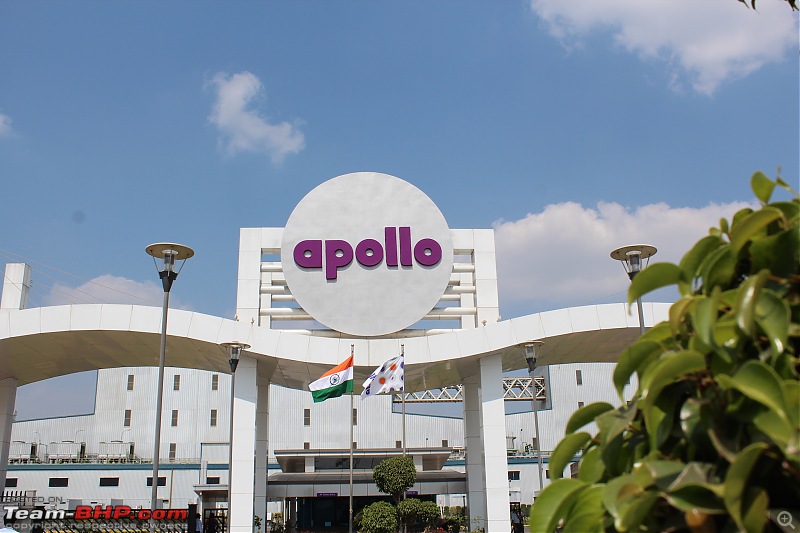 Fellow mod Suhaas307 and I visited the Apollo tyres factory near Chennai at Oragadam. This is Apollo’s newest greenfield manufacturing plant which commenced operation in 2010. We spent an entire day taking a close look at what goes into the making of the 4 important pieces of rubber on our cars. Before we go into details on the tyre manufacturing process, here’s a low down on the Apollo Chennai plant: • The plant is spread over 128 acres at Oragadam near Sriperumbudur. • The plant has a workforce of nearly 1,600 employees and is operational 24x7 with 3 shifts, working almost 365 days a year. • The plant manufactures only radial tyres for commercial vehicles known as 'Truck Bus Radials' (TBR) and 'Passenger Car Radials' (PCR). • Manufacturing capacity is currently at 16,000 passenger car radials and 6,000 truck bus radials. There is a massive expansion underway to increase the production of truck bus radials by 50% to 9,000 tyres/day. • There are 2 distinct manufacturing lines inside the plant, one for TBR’s and other for PCR’s. A central spine runs in between the 2 manufacturing lines which has the utilities like chillers, power backup, compressed air and the offices. Below is the map of the plant which shows the 2 manufacturing lines with the central spine. On the left is the larger TBR line whereas the right has the PCR line. On the extreme right are the utilities like power, steam and water treatment. The new TBR expansion is happening on the extreme left. The entry at the bottom is also where the raw materials come in and the huge warehouse at the back is where the finished goods are stored before dispatch. 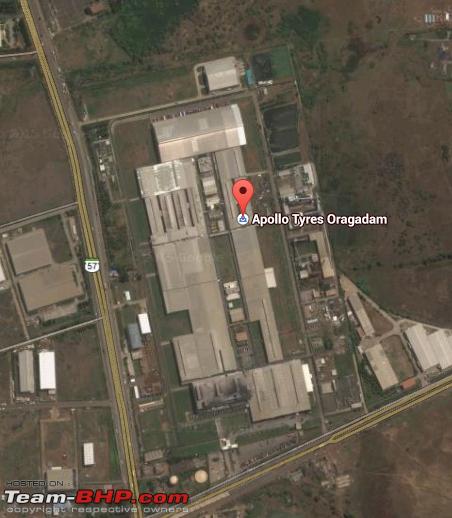 Last edited by Aditya : 3rd March 2015 at 10:49. |
| |  (43)
Thanks (43)
Thanks
|
| The following 43 BHPians Thank Vid6639 for this useful post: | aah78, Abhi_abarth, aeroamit, ampere, Arun.K, ashpalio, carrazy, dhanushs, Diesel_convert, Digital Vampire, dileepcm, Gansan, Grand Drive, GTO, hemanth.anand, im_srini, InControl, JoseVijay, kamath_d, kutts, Lobogris, mallumowgli, Mr.Boss, mrbaddy, noopster, paragsachania, parsh, procrj, Rehaan, rshanker, RSR, S2!!!, saket77, scopriobharath, SDP, Sheel, shetty_rohan, Technocrat, theexperthand, turbodude, vb-saan, VijayAnand1, Voodooblaster |
| |
| | #2 |
| Team-BHP Support  | Before we look at how a tyre is made, one needs to understand what a tyre consists of. What looks like one piece of rubber is actually far from that. A tyre is made up of several rubber compounds and multiple layers. The different layers that make up a tyre: Bead: This is the toughest part of the tyre. The bead basically consists of thick strands of steel wire that is encapsulated in rubber. It’s the part of the tyre that attaches to the rim. Sidewall: The sidewall consists of not just the sidewall rubber section but a chafer to strengthen the area above the bead as well. Inner liner: The inner liner is a soft layer that is impermeable to air. This is what basically replaces the tube in a tubeless tyre. Inner layers: The inner layers are multiple belts that consist of steel cords sandwiched between 2 rubber sheets as well as thread made of polyester & rayon, sandwiched between rubber sheets. These provide the structural strength to the tyre. Tread: This is the final top most layer of the tyre. The one that makes contact with the road. All the above components are made in the plant individually and they all come together to form the final tyre. Looking at a tyre you never realise the different raw materials that are needed to make the final product. Apart from the rubber which itself could be multiple types there are several other raw materials. Some of the raw materials were more like something you would see in a chemistry lab! Here are just few of the raw materials that we could see: Rubber: The rubber used could either be synthetic rubber (butyl rubber) or natural rubber (latex). This depends on which part of the tyre it goes into. For example, the inner liner uses synthetic butyl rubber. Other parts of the tyre like tread or sidewall may be a mix of both. The rubber is either imported or sourced locally. Steel Cords: Steel cords are used for the inner layers of a tyre as well as the bead. There are different types of cords depending on where they are used. The cords usually have a bronze coating to bond with the rubber. The steel cords are usually imported, either from Europe (Belgium) or Taiwan/China. Most tyres have multiple steel belts inside. The belts are like the main skeleton of the tyre. Fabric Cords: Along with steel cords, fabric is also used. The fabric cords are made from polyester, rayon or similar materials. Both steel and fabric cords are sandwiched between rubber sheets in a complicated process called calendering. Carbon black: A large % of the compound is carbon black. This is in-fact why the colour of a tyre is black! Carbon black provides better heat/uv resistance along with lower wear responsible for the tyre life. It is mixed with the rubber at the beginning. The higher the carbon content, the greater the life as well as strength - but of course this will have an impact on grip levels. Other chemicals: There are many other chemicals used such as sulphur that provide strength by vulcanization. Silica is used in modern tyres to reduce the rolling resistance of a tyre, aiding fuel efficiency. Last edited by Aditya : 3rd March 2015 at 10:51. |
| |  (39)
Thanks (39)
Thanks
|
| The following 39 BHPians Thank Vid6639 for this useful post: | aeroamit, anilntny, arakhanna, arnabchak, ashpalio, Chethan B G, Diesel_convert, diffsoft, Digital Vampire, Gansan, GTO, hemanth.anand, InControl, JoseVijay, kamath_d, mallumowgli, Mr.Boss, mrbaddy, navin, noopster, paragsachania, parsh, procrj, Rehaan, rshanker, RSR, S2!!!, Sheel, Soumyajit9, Technocrat, theexperthand, thoma, turbodude, V.Narayan, vaasu, vb-saan, VijayAnand1, Voodooblaster, wishnipon |
| | #3 |
| Team-BHP Support  | So how does all of this come together to form a tyre? Let’s take a look at the actual manufacturing process which consists of the following stages:
Mixing: This is where all the raw materials come together. The massive machines that do the mixing are called 'Banbury Mixers'. In simple terms, mixing is like putting all the ingredients inside a dough kneading machine. The Banbury mixers are almost 2 stories tall. We had to climb up to the first floor to see where the raw materials are fed in and then come down to see the final mixed product. The ingredients are fed into the machine according to which part of the tyre is being manufactured. It could be for the tread, inner liner, inner belts, sidewall or bead. The exact proportion of each ingredient is computer controlled using pre-programmed recipes. The mixer has an LCD screen that shows the recipe it is mixing and the next recipe in the queue. Sometimes mixing may be needed to be done multiple times. The ingredients added to the mixer are rubber, carbon black, sulphur, silica and other chemicals which result in the final compound - a black rubber putty like substance, which is then fed to an extruder. The plant has 8 mixing units in total. The Mixers are common for Truck Bus Radials as well as Passenger Car Radials. Post mixing, the manufacturing is split into two separate chains, one for TBR and other for PCR. Extrusion: There are multiple extrusion machines and stages of extrusion depending on which part of the tyre is being prepared. Extrusion is basically a press which creates the required shape and cross section needed. It involves passing through rollers which are heated to shape the compound. The first stage of extrusion is basically to take the putty like rubber dough from the mixer and form them into sheets which are stored for further processing. It passes through hot rollers and is then cooled by dipping into a special liquid to prevent the sheets from sticking to each other. Depending on what part of tyre that sheet is for, it is sent to a more specialized extruder. The plant has extruders for inner lining, sidewall, inner belt layers and the tread. These are super long conveyor belts that maintain the right tension on the rubber section as it passes through the multiple presses. Once passed through the extruder, you see the tread cut into the exact width of the tyre as well as the length. Shown here is the output of the mixer that is fed to the first stage of extrusion:  The Extruder machine:  Below 2 photos show various belts post extrusion:   Calendering: Earlier, I mentioned the steel and fabric cords that are used in the inner layers as belts, as well as in the bead. Calendering is where those cords are sandwiched between 2 of the rubber sheets. This is an extremely high precision and complex process. The steel cords come in rolls of 330 metres length. In one room there are multiple rolls placed on racks. From each roll the cord is pulled to the end of the room where it passes through a toothed-comb like metal insert. This maintains the exact distance between each cord. These are then fed to the calendering machine. The calendering machine has 2 huge drums one on top of each other which have the rubber belt from the extruder fed on either side. The 2 rubber belts meet in the centre where the cords are also fed. The drums are heated so the hot rubber is pressed together with the cords sandwiched in between. A similar process is followed in the case of fabric cords. In the case of the tyre bead, the end result is a loop which looks like a hoola-hoop. The inner belts are then chopped using a machine called a “pork chop” before they are sent for tyre assembly. The steel cords that are fed into the calendering machine:  Fabric cords that are fed into the calendering machine:  The calendering machine that has the 2 drums with rubber sheets and the fabric inserted in the middle:  Post calendering, the belts are suitably chopped:  Last edited by Aditya : 3rd March 2015 at 10:54. |
| |  (29)
Thanks (29)
Thanks
|
| The following 29 BHPians Thank Vid6639 for this useful post: | anilntny, ashpalio, Chethan B G, Diesel_convert, Digital Vampire, Gansan, Grand Drive, GTO, hemanth.anand, InControl, JoseVijay, kamath_d, mallumowgli, Mr.Boss, mrbaddy, navin, paragsachania, parsh, Rehaan, rshanker, RSR, S2!!!, scopriobharath, SmartCat, Technocrat, theexperthand, turbodude, V.Narayan, vb-saan |
| | #4 |
| Team-BHP Support  | Tyre Building: This is where all the individual pieces made in earlier stages come together. This step uses a tyre building machine which is partially hand operated by a skilled builder. The tyre builder consists of a barrel that is made of a rubber bladder. Over the rubber bladder you first place the inner liner then various inner belts as well as the sidewall. The edges of the rubber belts are pre-heated for easier adhesion. The bead loop is placed on both sides of the sidewall. Once all layers are in place the central rubber bladder inflates causing the tyre to wrap around the edges on the side. The machine pushes the sides and a pressing roller makes sure there are no loose ends. The barrel deflates and the technician removes the tyre from the machine. The result of this now begins to look like a tyre. Since this tyre is not yet cured but is pretty much ready it is called a “Green Tyre”. The tyre is bar coded as it now has all the components to make one model of the tyre in the range. The LCD display, above the building machine, displays the tyre details, for example - Apollo Alnac 205/65-15. The Tyre Building machine. As you can see the inner liner from the top conveyor belt wraps around the barrel:  The liner is then manually sealed:  The various belts are then mounted over the inner liner:  The technician checks the work to ensure there are no loose ends:  This machine is applying the "cap ply" which provides strength to the tyre and prevents the flex due to centrifugal force i.e. tyre pushing itself outwards due to high speed rotation:  The bead being attached to the sidewall belt: 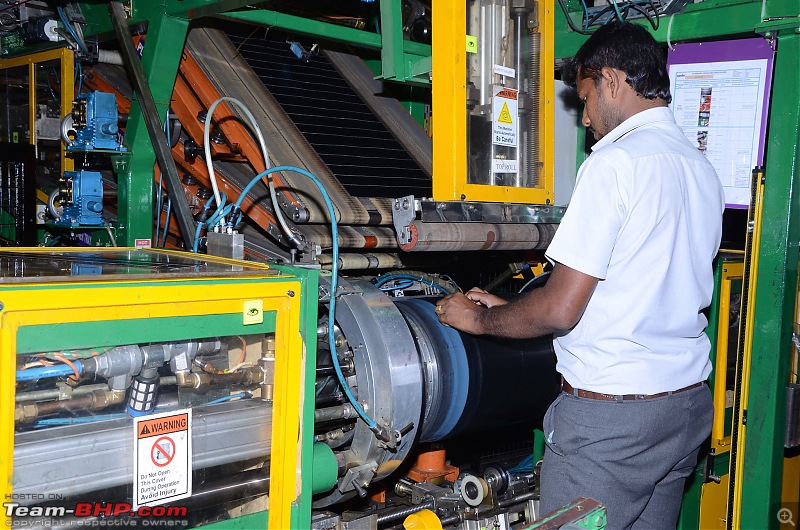 The machine has a rubber bladder inside which then expands and pushes from the sides to finally result in something resembling a tyre:   The final "Green Tyre":  Curing: Based on the bar coding, the tyre is now set for curing. The plant has hundreds of moulding machines. For the TBR’s there is a lift machine that carries the Green Tyre from the tyre building to the curing area. For PCR’s this is done manually using forklifts. The curing machine consists of a mould that is as per the specifications of that exact tyre size and model. There are hundreds of curing machines with moulds for the tyres that match. The Green Tyre is placed inside the mould and a rubber bladder inside inflates inside (similar to a the tube of a tyre). This bladder applies pressure outwards so that the tyre pushes out to the mould. The curing process is at a temperature of around 300 degrees C and the duration varies from 8 minutes to 20 minutes depending on the tyre and compound. The mould has the tread pattern and the sidewall lettering on it, including the date code which has week and year of manufacture mentioned. Every week the mould is modified with the current week code. What finally emerges post curing is the finished tyre. This is then moved onto a conveyor belt and sent for inspection. The Green Tyre being lifted to the curing oven:  The curing oven:  The tyre being placed inside the mould. You can see the grey rubber bladder which will later on inflate to push the tyre outwards towards the mould:  The top lid sealing the tyre for curing:  Finally after 8-20 mins the tyre emerges with the tread pattern and sidewall lettering:  The tyres are then placed on a conveyor belt and sent for inspection:  Inspection: The final tyre undergoes several inspections before it is deemed ready to ship. These include X-ray, visual inspection, balancing test as well as tests to check the true shape of the tyre. The balancing tells you the lightest/heaviest point on the tyre which is then marked by a red/yellow dot. This is the point where the tyre installer will usually mount the tyre onto the rim and align it with the valve to balance the weight. If all the inspections pass, the tyre is then stored in the warehouse as “Finished Goods” ready for dispatch. Inspection of the tyre by a machine that does the balancing as well as checks for the roundness:  A final visual inspection before it is sent for dispatch:   The Finished Good Storage warehouse, where the tyres are stored before they are shipped out:  Last edited by Aditya : 3rd March 2015 at 10:56. |
| |  (39)
Thanks (39)
Thanks
|
| The following 39 BHPians Thank Vid6639 for this useful post: | anilntny, asit.kulkarni93, Chethan B G, Diesel_convert, Digital Vampire, dkaile, er.sudhansu, Gansan, GTO, guyfrmblr, hemanth.anand, ilangop, JoseVijay, kiku007, KPS, mallumowgli, Mr.Boss, mrbaddy, navin, paragsachania, parsh, procrj, razor4077, Rehaan, rshanker, S2!!!, scopriobharath, Sheel, SmartCat, SunnyBoi, Technocrat, theexperthand, turbodude, Tushar, V.Narayan, vb-saan, VijayAnand1, Voodooblaster, wishnipon |
| | #5 |
| Team-BHP Support  | The Smaller Yet Significant Things Quality Assurance/Process Lab: During every stage of the manufacturing process, a sample is taken and tested at the dedicated laboratory. The raw materials like butyl rubber, latex and then the rubber that emerges from Mixing and Extrusion is tested for every new batch. Even the fabric and steel cords are tested for strength. Sulphur, Carbon Black, Silica and other chemical oils are all tested before they are cleared to be used for mixing. Rubber samples are tested using special instruments like a Mooney Viscometer or Rheometer. In the foreground; samples that are tested on a daily basis. In the background; the Mooney Viscometers (left) and Rheometers (right) that are used to test the viscosity of the samples:  The Rheometer applies pressure on the sample and heats up the rubber. A spindle is then inserted and a motor tries to turn the sample. The torque registered on the plate at the bottom determines the viscosity. A Rheometer has additional measurements that a Mooney Viscometer is not capable of. 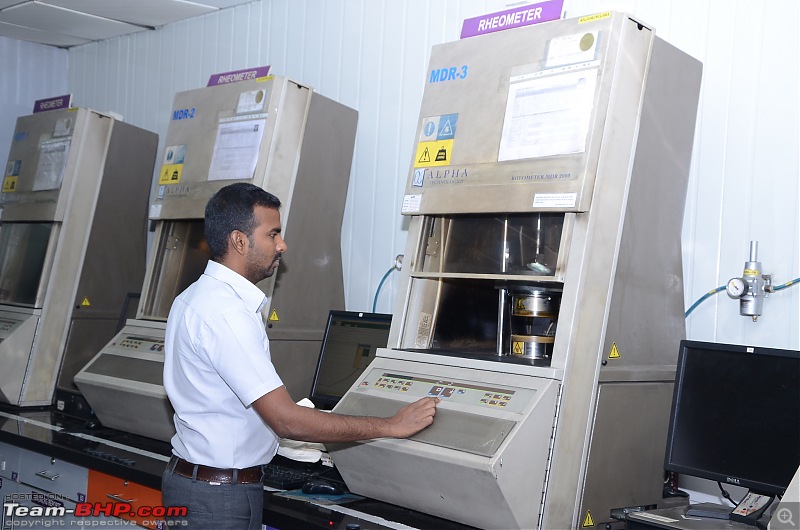 Different types of gauges for measurement: 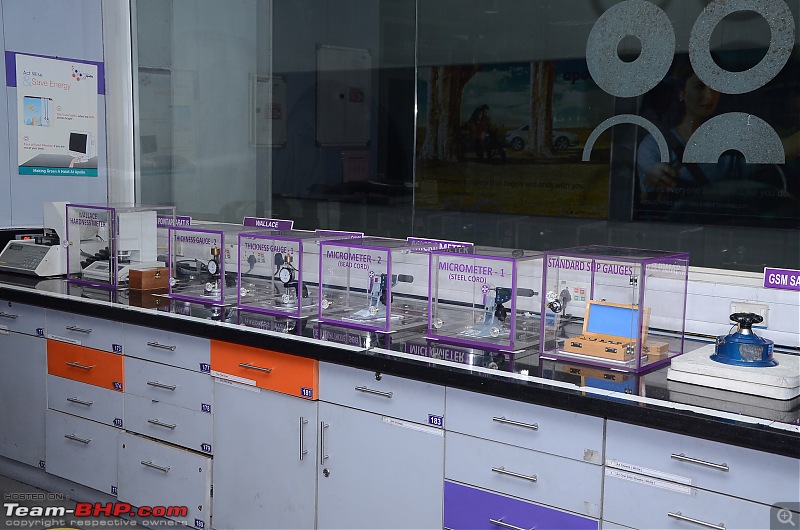 A moulding press. It is used to cure standard test pieces, so that testing of the compound properties can be performed on them (Credit to BHPian AbhiJ for pointing this out):  An oven that accelerates the wear rate to determine tyre life:  This machine tests the tensile strength of the bead wire or any of the other steel wires:  Utilities: Any large plant like this will need massive utilities. I was pretty amazed at the size of the Diesel Generators for backup power. Being in India, power cuts are to be expected. Due to the location (SEZ), power cuts are not as frequent and on most occasions are planned with the plant given a heads up. Nonetheless a power interruption can cause havoc in the plant. Imagine a power cut while curing or mixing at an high pressure, the entire batch will be ruined and will need to be thrown away due to the process disturbance. Critical areas of the plant that will lead to wastage of products are backed up by massive diesel generators, each the size of a small house. 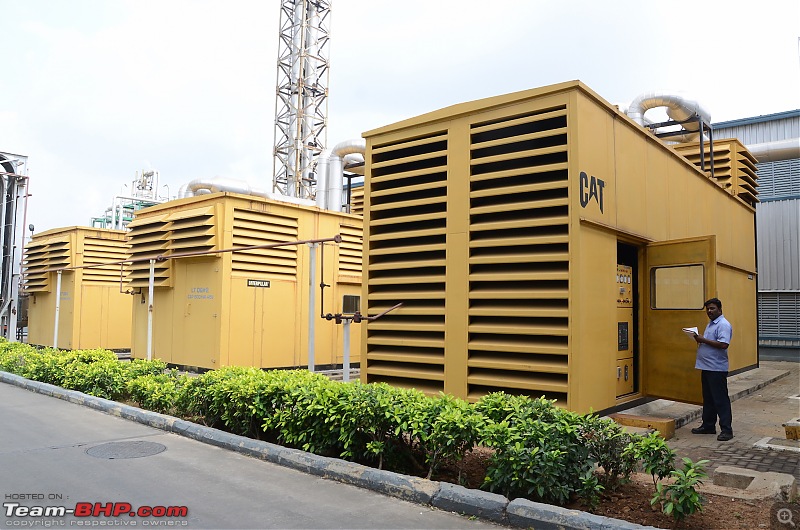 As mentioned earlier, the plant follows a unique design. Since there are 2 manufacturing lines, one for Truck Bus Radials and other for passenger cars. Since both need utilities such as power, chilled water and compressed air, the plant has a central spine that houses these utilities. On either side of the spine are the manufacturing lines. Chilled water plant for cooling:  On some occasions when there is a water shortage, the plant shifts to air cooling but this is very power intensive so is only kept as a backup:  • The entire operation of the plant can be monitored from a central control room. You can check power, water, status of every machine, instantaneous power consumption. The system is known as SCADA (supervisory control and data acquisition).   • Apart from these, there is a steam plant and water treatment plant. These are not in the centre spine as they take up a lot more space. • The plant has several canteens spread out to reduce the time taken for walking towards a central canteen. Due to the sheer size of the plant, it can get pretty exhausting walking inside the plant. Moreover, we were required to wear metal shoe caps as a safety measure and a fluorescent jacket. Our feet were aching towards the end of the day! • There's even a library that houses various car magazines as well as a desktop to browse through sites like Team-BHP  . A knowledge sharing room has several papers written in international conferences. . A knowledge sharing room has several papers written in international conferences.• The plant is involved several CSR activities like HIV/AIDS awareness, eye checkups, waste management, upgrading skills of the residents in nearby villages (e.g. teaching truck driving). • Since the plant operates 24x7 and uses a fleet of forklifts running around, there is a dedicated forklift service station. There's even a battery charging station. The batteries are charged separately and are swapped out with the batteries in the charging station. No downtime for charging at all. • The plant focuses heavily on safety. They follow a different model known as BBS (Behaviour Based Safety). This concentrates more on the employees behaviour rather than training for safety. Basically an employee who is clumsy or not careful is bound not to be safe no matter how much training is given. They look at why people do what they do, and then look at ways to prevent it. More on BBS. Last edited by Aditya : 3rd March 2015 at 11:00. Reason: Adding information shared by AbhiJ :) |
| |  (40)
Thanks (40)
Thanks
|
| The following 40 BHPians Thank Vid6639 for this useful post: | amitwiz1, ashpalio, Chethan B G, dhanushs, Diesel_convert, Digital Vampire, Gansan, GTO, hemanth.anand, JoseVijay, Kumar R, mallumowgli, Mr.Boss, mrbaddy, navin, paragsachania, parsh, phamilyman, procrj, Rehaan, rki2007, rshanker, RSR, S2!!!, sajusherief, saket77, scopriobharath, sdp1975, Sheel, SmartCat, SS-Traveller, subbaramu, suhaas307, Technocrat, theexperthand, TheTeacher, turbodude, V.Narayan, vb-saan, Voodooblaster |
| | #6 |
| Team-BHP Support  | Other Points: • We had a brief interview with Satish Sharma (President of APAC) who gave us a high level overview of the plant and about the company. When asked about Vredestein he mentioned a few points:
• Apollo R&D centre where the tyres are designed and tested is based out of the Netherlands (Enschede, near Amsterdam). The Chennai plant makes the prototypes but they don't do the on road testing. The Oragadam plant doesn't have a test track either. They use the MMST track nearby for some tests. • Surprisingly the Apollo plant also makes Falken tyres that are sold in India, since Falken doesn't have its own manufacturing unit. I was quite shocked to see a 'Made in India' Falken tyre coming out of the plant. The tyres were all the entry level Sincera SN835 series. • Apollo is pretty much the OEM choice for all Indian car manufacturers now except for Toyota. Expect this to change in 2016 when the new Innova comes shod with Apollo rubber. • Winter tyres for the European market made in sunny and tropical Chennai! They are sold as Apollo Alnac Winter tyres. They aren't the studded type, but just have the winter tread pattern. • While leaving the plant we happened to see the under construction expansion area of the plant. This is expected to increase the capacity for truck bus radials by 50% from 6,000/day to 9,000/tyres per day. Factory expansion under way and the ride of choice to Chennai  . We weren't going to fly to Chennai! . We weren't going to fly to Chennai! • Disclaimer: Apollo Tyres invited Team-BHP for this factory tour. They covered the accommodation expenses for this event. • All photos courtesy Apollo Tyres. (Photography was not permitted inside the plant). • This video sums up the entire manufacturing process: A final goodbye to the plant just before we left:  Last edited by Aditya : 3rd March 2015 at 11:02. |
| |  (69)
Thanks (69)
Thanks
|
| The following 69 BHPians Thank Vid6639 for this useful post: | Abhi_abarth, abishek2222, aeroamit, Aficionados, Akshay1234, amitkb, anilntny, Arun.K, Ashir, Captain Slow, carrazy, Chethan B G, cool_chelly, dhanushs, Diesel_convert, Digital Vampire, dileepcm, EDDY21.05, el lobo 6061, fiat_tarun, Gansan, gostel, gschandra, GSMINC, GTO, guyfrmblr, harish_K, hemanth.anand, hillsnrains, InControl, JoseVijay, Karthik Chandra, khoj, KPS, lamborghini, mallumowgli, Motard_Blr, Mr.Boss, mrbaddy, navin, paragsachania, parsh, phamilyman, procrj, razor4077, Rehaan, rki2007, rshanker, RSR, RYP, S2!!!, sai_ace, saket77, scopriobharath, Sheel, SmartCat, Soumyajit9, suhaas307, SunnyBoi, Technocrat, theexperthand, thoma, V.Narayan, vaasu, vb-saan, vhharan1, VijayAnand1, Voodooblaster, zesty |
| | #7 |
| Team-BHP Support  | Re: PICS: Apollo Tyres Chennai Factory. Detailed report on the making of a Tyre Thread moved from the Assembly Line to the Tyre Section. Thanks for sharing! Appreciate the explanation & sheer attention-to-detail  . Rating thread a well-deserved 5 stars! . Rating thread a well-deserved 5 stars! |
| |  (4)
Thanks (4)
Thanks
|
| The following 4 BHPians Thank GTO for this useful post: | RSR, suhaas307, Vid6639, wishnipon |
| | #8 |
| BHPian Join Date: Oct 2013 Location: Bengaluru
Posts: 45
Thanked: 14 Times
| Re: PICS: Apollo Tyres Chennai Factory. Detailed report on the making of a Tyre Very well written and explained. Never thought that the simple tyre had so many processes before it is manufactured. Just curious as to where the raw materials are procured? Are they imported? |
| |  (1)
Thanks (1)
Thanks
|
| The following BHPian Thanks jasonblr for this useful post: | Vid6639 |
| | #9 |
| Senior - BHPian | Re: PICS: Apollo Tyres Chennai Factory. Detailed report on the making of a Tyre Very informative and well written. Something very interesting and different from other TBHP reviews. It should give every TBHP member a proud feeling to know that not only car makers but even other associated with auto industry are recognising the impact of TBHP and its outreach. I know the guy in the 2nd photo in your post# 5 but cannot recall his name. Am probably getting old. As the saying goes that a man is recognised by the shoes he wears, IMO the same goes for the tyres on his car. Raab rakha. Last edited by ariesonu : 11th February 2015 at 18:23. |
| |  (1)
Thanks (1)
Thanks
|
| The following BHPian Thanks ariesonu for this useful post: | Vid6639 |
| | #10 |
| Distinguished - BHPian  Join Date: Aug 2014 Location: Delhi-NCR
Posts: 4,325
Thanked: 72,152 Times
| Re: PICS: Apollo Tyres Chennai Factory. Detailed report on the making of a Tyre Dear Vid6639, thank you for this highly educative thread explained in a simple lucid manner. Happy to have learnt something new today thanks to you. Best regards - Narayan. |
| |  (1)
Thanks (1)
Thanks
|
| The following BHPian Thanks V.Narayan for this useful post: | Vid6639 |
| | #11 | |
| Senior - BHPian Join Date: Jun 2008 Location: Kolkata
Posts: 1,498
Thanked: 1,256 Times
| Re: PICS: Apollo Tyres Chennai Factory. Detailed report on the making of a Tyre Great Thread! Quote:
| |
| |  (6)
Thanks (6)
Thanks
|
| The following 6 BHPians Thank AbhiJ for this useful post: | Eddy, GTO, Latheesh, mallumowgli, Rehaan, Vid6639 |
| |
| | #12 |
| BHPian Join Date: Dec 2014 Location: Chennai
Posts: 48
Thanked: 54 Times
| Re: PICS: Apollo Tyres Chennai Factory. Detailed report on the making of a Tyre Awesome Thread! Kudos to Vid6639 for the walk-through. Rated it a well deserving 5 stars . Visiting supplier factories is always exciting and one can learn technically a lot of stuff because its truly "Manufactured" from scratch.  Last edited by GTO : 12th February 2015 at 14:58. Reason: Typo |
| |  (1)
Thanks (1)
Thanks
|
| The following BHPian Thanks Rev_That_V8 for this useful post: | Vid6639 |
| | #13 | |
| BHPian | Re: PICS: Apollo Tyres Chennai Factory. Detailed report on the making of a Tyre Quote:
I mean, there's a myth that OEM tires cost only a few hundred rupees to the automobile manufacturers, would be interesting to know if the tires meant for OEM consumption are built differently. | |
| |  (1)
Thanks (1)
Thanks
|
| The following BHPian Thanks im_srini for this useful post: | Vid6639 |
| | #14 | |
| Team-BHP Support  | Re: PICS: Apollo Tyres Chennai Factory. Detailed report on the making of a Tyre Quote:
Some OEM's will ask for stringent requirements. If at all they do modifications for one OEM it is done for all and not separate distinction for any particular OEM. | |
| |  (4)
Thanks (4)
Thanks
|
| The following 4 BHPians Thank Vid6639 for this useful post: | Abhi_abarth, Chethan B G, er.sudhansu, paragsachania |
| | #15 |
| BHPian Join Date: Aug 2012 Location: Bangalore
Posts: 148
Thanked: 159 Times
| Re: PICS: Apollo Tyres Chennai Factory. Detailed report on the making of a Tyre Nice thread Vid! Did you ask them if they plan to compete with zlo / zsport class of tire ? |
| |  (1)
Thanks (1)
Thanks
|
| The following BHPian Thanks Diesel_convert for this useful post: | Vid6639 |
 |


